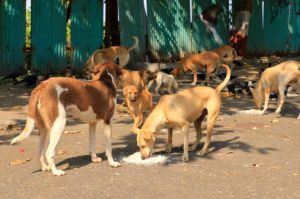SC Order on Stray Dog Management: The Supreme Court of India’s recent order on the management of street dogs has created an unusual sense of unity among animal welfare groups in Kolkata. For years, these organisations have disagreed on feeding locations, sterilisation drives, and even the handling of aggressive dogs. But this time, the city’s various “dog factions” have found themselves echoing the same concern: Can this directive actually be carried out in Kolkata’s complex urban environment?

Understanding the Supreme Court Order
The Supreme Court ruling is aimed at balancing three crucial concerns:
- Public safety – reducing dog bite incidents and aggressive behaviour.
- Animal welfare – ensuring humane treatment and preventing cruelty.
- Population control – implementing sterilisation and vaccination in a systematic, large-scale manner.
The guidelines outline specific measures such as:
- Sterilisation & vaccination under the Animal Birth Control (ABC) Rules, 2023.
- Designated feeding zones to minimise conflict with residents.
- Relocation of aggressive dogs only under authorised protocols.
- Monitoring & record-keeping by municipal authorities.
While the intention is clear, the implementation in a city as densely populated and socio-culturally complex as Kolkata poses major challenges.
📎 External References:
- Animal Birth Control Rules, 2023 – Ministry of Fisheries, Animal Husbandry & Dairying
- Supreme Court Judgments Portal
The Scale of the Challenge in Kolkata
Kolkata is estimated to have over 70,000 street dogs spread across its wards. While some are sterilised, a large number remain unvaccinated, posing both health risks and challenges to population control.
The Kolkata Municipal Corporation (KMC) conducts sterilisation drives, but with only a handful of functional sterilisation centres and limited veterinary staff, meeting the targets set by the Supreme Court will require a massive scaling-up of resources.
A KMC official, requesting anonymity, said:
“We understand the court’s intention, and we are committed. But the reality is that our sterilisation facilities and transportation arrangements for catching and releasing dogs are stretched thin. Without significant funding and cooperation from citizens, progress will be slow.”
A Rare Moment of Agreement Among Animal Welfare Groups
Kolkata’s animal welfare organisations have often been divided. Some focus on rescue and rehabilitation, others on street feeding, while a few work closely with municipal authorities on birth control programs.
Historically, disputes have broken out over:
- Locations and timings of feeding street dogs.
- Handling cases of aggression.
- Relocation protocols and their legality.
But with the Supreme Court’s latest directive, these groups are speaking in one voice — to highlight the practical difficulties ahead.
One prominent animal activist explained:
“In theory, the order is balanced and protects both humans and animals. But implementation requires infrastructure, trained personnel, and above all, coordination. We are struggling with the basics — getting enough vans to transport dogs to sterilisation centres, ensuring post-operative care, and tracking vaccinated dogs.”
The Role of Designated Feeding Zones
The idea of creating specific feeding zones has received mixed reactions. Supporters say it will reduce conflicts between residents and dog feeders while ensuring dogs receive food in a hygienic manner.
Critics argue that street dogs are territorial and feeding them in locations away from their existing areas could lead to fights, disorientation, and increased aggression.
Animal behaviour experts caution that any change in feeding patterns must be gradual and paired with consistent monitoring.
📎 Learn More: Guidelines on Street Dog Feeding – Animal Welfare Board of India
Public Sentiment — Between Safety and Compassion
The public is deeply divided.
- Safety concerns dominate conversations in residential complexes, where dog bite incidents and aggressive chases by packs have been reported.
- Compassion-driven arguments come from citizens who view street dogs as part of the city’s ecosystem and believe sterilisation, not removal, is the humane solution.
A Salt Lake resident recalled a recent incident:
“My neighbour’s child was bitten while cycling. I’m not against dogs, but when children’s safety is at risk, the authorities must act quickly.”
Meanwhile, a feeder from Behala shared:
“Most street dogs are friendly if treated kindly. Removing them is not the solution; managing and caring for them is.”
SC Order on Stray Dog Management: Comparing With Other States
The challenges Kolkata faces are not unique. In cities like Bengaluru and Jaipur, sustained sterilisation drives combined with community awareness campaigns have led to noticeable reductions in the stray dog population over a decade.
However, in other states where municipal cooperation was weak or community resistance was high, the programs failed, leading to recurring tensions between residents and animal rights advocates.
Experts stress that Kolkata can learn from both sets of experiences — scaling infrastructure like Bengaluru while avoiding missteps that derailed progress elsewhere.
Recommendations From Experts
To bridge the gap between the court’s vision and Kolkata’s reality, experts suggest:
- Expand Infrastructure – Build more sterilisation centres across wards.
- Mobile Veterinary Units – Reduce transportation delays by treating and sterilising dogs closer to their territory.
- Community Training Programs – Equip feeders with training on hygiene, first aid, and safe interaction with dogs.
- Digital Dog Tracking – Use tags or microchips to maintain vaccination and sterilisation records.
- Public Awareness Campaigns – Reduce fear, promote coexistence, and educate on preventing bites.
- Dedicated Funding – Secure state and central government support to ensure consistent resources.
The Road Ahead
While the Supreme Court’s directive has the potential to create a structured, humane approach to managing street dogs, the consensus among both activists and authorities is that without a major operational push, the order risks being reduced to another well-meaning but under-implemented policy.
The next few months will reveal whether Kolkata can transform this challenge into an opportunity — one that safeguards public safety while respecting the lives of its street animals.
📎 Further Reading:
Also read: Home | Channel 6 Network – Latest News, Breaking Updates: Politics, Business, Tech & More

